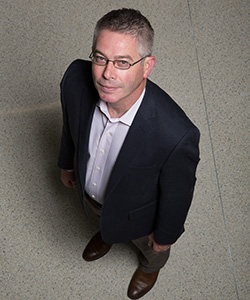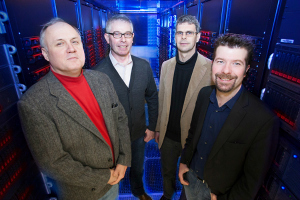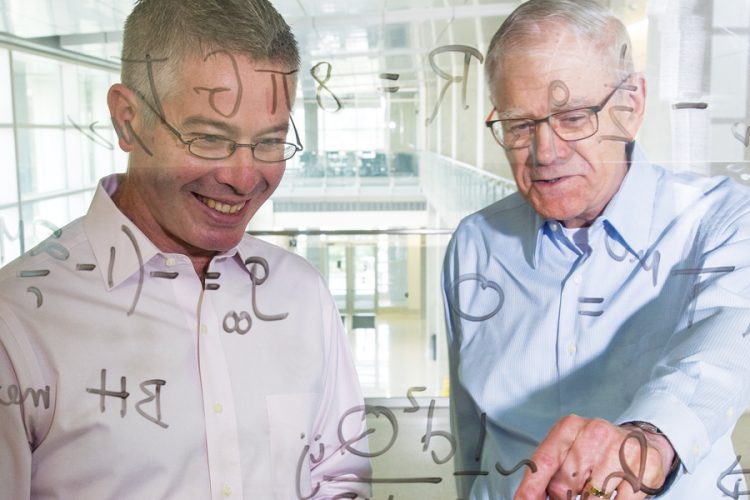It was an ordinary Monday morning in September for Patrick Brady. The physics professor walked into his kitchen, poured a cup of coffee and opened his laptop. Scrolling through his email, one subject line caught his eye.
“Hang on,” he said to himself. “Here’s something that looks really interesting.”
Brady, director of UWM’s Leonard E. Parker Center for Gravitation, Cosmology and Astrophysics, opened a data program built and maintained by a team of UWM physicists and worldwide collaborators, some of whom are former UWM students.
And there it was: notification that ultra-sensitive instruments in Louisiana and Washington had apparently collected data from a gravitational wave. If the readings were correct, the never-before-recorded phenomenon, born in deep space, had washed over the Earth at 4:50 a.m. Central time that very morning, Sept. 14, 2015.
“It took just three minutes to get data from the instruments,” Brady recalls, sitting in his sunlight-drenched office in the Kenwood Interdisciplinary Research Complex, or KIRC. “Then it was, ‘OK, what do we know so far?’ Wow was the answer.”
Within a couple of days, scientists calculated that two black holes had collided and merged 1.3 billion years ago, sending shockwaves – or gravitational waves – into the universe and creating a single black hole 62 times the mass of our sun.
The gravitational wave was such a huge discovery within the physics community that it’s almost hard to quantify. Until that first detection, the concept of the waves had existed only in mathematical equations. Albert Einstein in 1915 had predicted the waves’ existence as he formulated his theory of general relativity, which, simply put, shows how space and time are curved by matter and energy, resulting in the fundamental force of gravitation. Einstein doubted it would ever be possible to detect gravitational waves as they ripple invisibly through the universe, and for decades, scientists tried in vain to develop a successful way to observe them.
But Einstein’s doubts were put to rest on that fateful Monday morning in September, 100 years after he published his famed theory. Three months later, on Dec. 26, 2015, a second gravitational wave was detected, confirmation that the first was not just a one-off chance encounter.
“Gravitational-wave astronomy has truly started,” Brady said soon after the news. An entirely new field of science is emerging with the invention of a fresh way to peer into the universe. The detection of gravitational waves will produce data about celestial objects and cataclysmic events that occurred billions of light years away, opening doors to cutting-edge research projects in physics, astronomy and astrophysics that wouldn’t be possible with conventional telescopes.
The deep-space breakthrough has had repercussions close to home, too.
UWM’s involvement in the project has generated some $25 million in federal grants and bolstered its national standing as a research institution. In February 2016, the Carnegie Classification of Institutions of Higher Education placed UWM among the 115 first-tier doctoral universities in the United States. UWM had coveted such status for years, and projects such as the gravitational-wave research helped achieve it.
The method for observing a gravitational wave originated in 1972, when Massachusetts Institute of Technology physicist Rainer Weiss outlined the design of what would become the Laser Interferometer Gravitational-Wave Observatory, or LIGO.
Conventional telescopes cannot directly observe a black hole, where gravity is so powerful that even light does not escape, nor can telescopes see the gravitational waves that emanate from black holes. So scientists devised sophisticated laser technology that measures the minute effect of a gravitational wave as it passes over the Earth. LIGO observatories were constructed, beginning in 1994, in Livingston, Louisiana, and Hanford, Washington. In 1997, founders of the project organized the LIGO Scientific Collaboration, now made up of more than 1,000 scientists from 90 institutions around the world.
UWM’s LIGO group was among the founding members. Its faculty, postdoctoral researchers and grad students helped design and build the tools – a cluster of computers, databases and programs – that move data from the observatories to LIGO’s computer centers. They also helped analyze the data that confirmed the gravitational wave discovery.
Brady serves on the collaborative’s executive committee and chairs LIGO’s data analysis software working group. Weeks after the first wave was detected, he joined a conference call to track the results of LIGO’s deep analysis of the findings.
“Around the world,” he says, “hundreds of people watched as the webpage revealed what the results said. And it was that day that we knew this thing was five-sigma.” It’s the highest statistical measurement of confidence among scientists that their discovery is accurate and not related to chance.
* * *

A short walk down the hall from Brady’s office is one reserved for physicist Leonard Parker. A UWM emeritus professor, Parker has spent his career devising theories relating to the expanding universe. His trailblazing theory of the creation of particles – or mass – in the universe inspired thousands of published papers by physicists around the globe and put him on par with some of the biggest names in the field.
Dressed in a tweed sport jacket, Parker is modest and soft-spoken. He speaks humbly and sparingly about his professional achievements, focusing instead on the work of his mentors and peers, while extolling the prominence of UWM’s physics department.
Still, it is his name that graces the Center for Gravitation, Cosmology and Astrophysics, a research center that has grown in size and stature since Parker was named its founding director in 1997.
At one point, Parker’s theories paralleled Stephen Hawking’s black hole theories. “His work set the scene for Hawking’s discovery that black holes do create particles,” says Brady, whom Parker promoted in 2007 to head the center. “That field – Leonard was the founder of it – was just a burgeoning field through the ’70s and into the ’80s, and of course has had a profound impact on our understanding of the universe and of black holes in recent times.”
Like many physicists, Parker contemplated the existence of gravitational waves decades before they were detected. And in some ways, his work was a steppingstone for the development of LIGO.
Parker retired in 2008, or “supposedly retired,” as he says. He worked with doctoral students for a few more years, and he still logs onto his computer from his home office these days. Sometimes, he walks to campus to join staff and students in colloquia and seminars. His KIRC workspace features thick texts stacked on bookshelves and the floor. One shelf holds his doctoral thesis, “The Creation of Particles in an Expanding Universe,” 360 pages of mathematical genius that caught the eye of the physics community when it was published.
That was 1966. Parker has been on a theoretical quest of the cosmos ever since.
He was born in Brooklyn in 1938. As a boy, he had a keen awareness of the role science played in World War II. “By the time the war ended in 1945, I had heard about nuclear fission and things like that,” he says. He was drawn to science early, conducting chemistry experiments in his parents’ basement, studying fruit flies in school. To gaze at the stars, he built a 3-inch reflecting telescope.
“At 12, I decided I wanted to be a physicist,” he says.
Neither of his parents graduated from high school. “They had to go to work,” he says. His father continued in the family’s traditional profession by running a dress-manufacturing business in New York’s garment district. Parker’s paternal grandfather, a Jewish immigrant from Lithuania, had also worked in textiles. Meanwhile, his mother’s parents – Jewish immigrants from what is now the Ukraine – opened a grocery store in Brooklyn. Parker’s family eventually bought a house in Jamaica Estates, an upper-middle-class neighborhood in Queens.
Accepted into the prestigious Bronx High School of Science, Parker excelled. He was also a member of the Manhattan Chess Club, where he often played against – and lost to – a 12-year-old Bobby Fischer, who’d become history’s 11th world chess champion. Graduating high school in 1956, Parker enrolled at the University of Rochester in upstate New York. There, he met his wife, Gloria, who was studying elementary education. They married in 1961.
Since early in high school, Parker had been reading Einstein. “There were these statements you would always hear about relativity of time and blah blah blah,” he says. “So I tried to actually understand that. My next-door neighbor was the editor at Philosophical Library, which published books on Einstein. He would give me some of those books to read. I remember I was very excited about it all.” The neighbor had even planned to introduce Parker to Einstein, but Einstein died in 1955 before a meeting could be arranged.
Parker graduated from Rochester summa cum laude and was accepted into a graduate program at Harvard University. Suddenly, he was breathing the same air as many of the world’s eminent physicists, some of whom would win the Nobel Prize – Julian Schwinger in 1965, Sheldon Glashow in 1979 and Roy Glauber in 2005.
Parker studied Einstein’s theory of general relativity as an undergrad, and it flowed into completing his doctorate. His challenge was to work at “the interface” of general relativity – the theory that gravity is in the space-time continuum that’s created by the presence of mass – and quantum field theory, which relates to the collection, or field, of subatomic particles and how they form and disappear.
Gloria worked at the Smithsonian Astrophysical Observatory, analyzing satellite orbits, while the couple lived in Cambridge, Massachusetts. There, they had their first child, David, who’s now an engineer. After completing his thesis, Parker was asked to teach quantum mechanics for a year at the University of North Carolina, and the family moved to Chapel Hill. Their second child was born, Michael, today a doctor.
With his doctorate complete and his stint at UNC over, Parker began searching for a job. “I had a rude awakening when I realized I had to look for a position,” he recalls. “I was very happy to be teaching. I didn’t realize that you had to worry about making a living. What a trivial thing, you know.”
It was a hard time for physics departments around the country. Government funding was in short supply, and teaching positions were highly coveted. But in 1968, with his thesis published and receiving outstanding reviews, Parker accepted a position at UWM as an assistant professor, teaching and working on quantum field theory.
The post was a good fit. With his groundbreaking work, he had made a name for himself. Graduate students and postdocs applied to work with him in the physics department and hear him lecture. Editors of scientific journals asked him to edit scholarly papers.
Meanwhile, he and his wife grew comfortable in Milwaukee. “I felt it was right locating in Milwaukee for my children. I felt the most important thing was to bring up your children,” Parker says. “I’m not overwhelmed by people who are successful and not spending time with families.”
Their third child, Debbie, now an occupational therapist, was born in Milwaukee, and when the children were in high school, Gloria became a certified diabetes educator and dietician. She’d eventually take a position at the Diabetes Treatment Center at Columbia St. Mary’s Hospital, where she works today. The Parkers have four grandchildren.
A few years after moving to Milwaukee, Parker was asked to spend a year in the physics department at Princeton University, teaching, supervising thesis students and studying under John Wheeler, the theorist who’s credited with coining the term “black hole.” Parker’s stint as visiting professor came on the heels of his first National Science Foundation grant, which would be renewed annually for 40 years at UWM. It also placed him in the city where Einstein lived for much of his life.
At Princeton, he was invited to join the esteemed Institute for Advanced Study, Einstein’s academic home. “I looked through the paperwork,” he remembers. “I thought I must be a visiting fellow or something. It was only later that I realized I was a member.”
While at Princeton, he’d wanted to apply his theory of the creation of particles to the formation of a black hole as matter collapses into it. Other pressing assignments and teaching duties pulled him away from the idea, however, and he didn’t get to the point of publishing his proof. “I was a pretty diffident guy,” he says. “I never wanted to really push my stuff.”
He eventually published the paper in 1975. But by then, Hawking had solved the proof, showing how particles are emitted as a black hole is formed, generating radiation. Hawking submitted a paper for publication just three weeks before Parker’s submission was received. Parker had been scooped.
“It turned out I was not as productive as I should have been,” he says. “That was the problem that Hawking solved, in a beautiful way, using a different method.”
Still, he remained at the top of his game as an internationally renowned physicist throughout his career.
In 2011, Milwaukee philanthropists Alfred and Isabel Bader made a generous donation to UWM in Parker’s name. Alfred Bader, a Harvard grad and chemist who founded Aldrich Chemical Co. in Milwaukee, had been a good friend of Parker’s since the late 1960s. And as a condition of the $1.6 million gift, he and his wife asked the university to rename the physics center the Leonard E. Parker Center for Gravitation, Cosmology
and Astrophysics.
Humbled yet hesitant, Parker tried to talk them out of it. “I thought it should have been named after Alfred,” Parker says, “but he insisted that it be named after me.”
* * *

From behind his desk, with a laptop, desktop computer and cell phone within easy reach, Patrick Brady spins entertaining narratives as he explains the complexities of gravitational physics. Speaking in a patient and at times lyrical manner, his Irish origin
is betrayed by a slight brogue.
Brady, 50, grew up in Dublin. His father was a sheet-metal worker who toiled on automobiles, and his mother was a homemaker. “My dad was a very talented man with his hands, incredibly good at solving problems that required manual labor. I learned a lot,” he says. “People sometimes make fun of me in the LIGO collaborative because they think of me as a theorist who doesn’t know how to do any experimental things.
“But, you know,” and he smiles as he sets up the punch line, “I know how to change the clutch in a Mini Cooper in four hours. You can’t tell me that I don’t know how to use my hands.”
He was the first in his extended family to attend university, and both of his parents stressed the importance of higher education. “Dad would always say, ‘Education is no load to carry.’”
After Brady completed a degree in mathematical science at University College in Dublin, a professor’s recommendation led him to a three-year stint at the University of Alberta in Edmonton, Canada, to study with Werner Israel, a leading black hole theoretician.
His interest in gravitational physics had started earlier, when he became fascinated with black holes in the 1970s. “I was a young kid at the time,” he says, noting he was born a year after a famous mathematical result was published by English physicist Roger Penrose. “He wrote a very short two pages in which he essentially convinced the world that objects must collapse down to form black holes.”
A renaissance in black hole theory was underway, led by the likes of Wheeler, Penrose, Israel, Hawking, Parker and Kip Thorne, one of LIGO’s three founders. In the face of ample scientific skepticism about the existence of so-called dark stars, “they were making fabulous discoveries about black holes and learning what Einstein’s theory told us about black holes,” Brady says. “That science was leaking into the popular culture.”
While vacationing in the U.S. with his family a few years later, he rummaged through stores searching for books on Einstein’s work. “At that point, I was thoroughly fascinated with Einstein’s theory of relativity. In particular, I wanted to do the math.”
For Brady, the road to LIGO started in 1995 when he was a postdoctoral researcher at Newcastle University in northeastern England. Unexpectedly, he received an email from Thorne, who was a professor at the California Institute of Technology. Thorne offered him a fellowship, and Brady began working on gravitational wave detection at Caltech, developing software for analyzing and interpreting data.
A few years earlier, Thorne, Weiss and Ronald Drever, an experimental physicist from Scotland, had won funding for the LIGO project from the National Science Foundation, allowing them to assemble a team and begin designing the detector. The ongoing funding would eventually top $1 billion, making it the largest NSF-sponsored experiment in history. Finding a new way to look at the universe was deemed that important.
Meanwhile, at Parker’s urging, UWM hired theoretical physicist Bruce Allen. Allen had worked at MIT with Weiss, the original designer of the LIGO apparatus, and completed his doctorate under the guidance of Hawking at Cambridge University. While visiting LIGO scientists at Caltech, Allen met Brady.
“UWM’s involvement in LIGO began with Bruce Allen,” Brady says. “He convinced the university soon after he arrived that hiring somebody – which turned out to be me – in gravitational waves would be a good idea.” Brady accepted a position at UWM in 1999.
Soon after moving to Milwaukee, Brady met Rachel McGraw at a singalong at an Irish bar. They married and now live in the Riverwest neighborhood. A Milwaukee native, Rachel was a study abroad coordinator at UWM’s Center for International Education before she started work on a doctorate in geography at UW-Madison.
“She’s also become my spokesperson,” Brady says. “She gives the spiel at cocktail parties of what I do. She’s very understanding of the complexity of the project and how long it took to get here.”
Around the same time as Brady’s arrival, UWM recruited fellow Caltech researchers Alan Wiseman and Jolien Creighton. They were helping design the LIGO computer infrastructure that would be up and running if and when a gravitational wave arrived. UWM’s LIGO team of data analysts was strong and getting stronger.
Bruce Allen moved on in 2007 to become director of the Max Planck Institute for Gravitational Physics in Hannover, Germany. But with Brady as the center’s director, UWM continued to grow the LIGO group, recruiting Xavier Siemens later that year. And with that steady growth came research grants: During the past decade, the LIGO group has garnered some $25 million in National Science Foundation grants.
“We’ve been very strategic within the last decade, adding faculty with a strategic view for gravitational-wave astronomy,” Brady says. “Part of the effort is to open up that field, and then to work on the science that would come after we made the first discovery.”
The paper announcing the detection of the first gravitational wave was published on Feb. 11, 2016. It was signed by 1,004 authors from around the globe. About 20 were from UWM, including Brady, Creighton, Siemens and Wiseman. Another 20 to 40, Brady says, had close connections to UWM, usually as former students or faculty members who had moved on to other institutions.
The paper has been cited in more than 500 scientific articles. “That is very unusual,” Brady says. “Most of those articles are written by other scientists about what the meaning of this observation might be. There are all sorts of wonderful ideas.”
The detection of gravitational waves was a “revolutionary” moment in modern science, Brady says. “As we learn more, we’re going to understand more about how stars come to life, how they live, how they die, how the universe changes with time. It’s just going to be huge.”
* * *

In spite of his modest nature, Leonard Parker is greatly respected within the scientific world. His work is widely cited. He shares the podium at conferences with the likes of Hawking and Paul Davies, an English physicist and best-selling author. At an August 2015 conference on quantum field theory in Stockholm, Sweden, Davies noted that if it weren’t for Parker’s work, none of the participants would have been there.
Through the 1970s, ’80s and into the ’90s, the pioneering research of Parker and colleagues Bruce Allen and John Friedman – the former chairman of the department and now professor emeritus – placed the physics department on par with some of the best in the world. That includes such places as Cambridge, Caltech and the University of Chicago, distinguished company that lifted the entire status of UWM.
On the shoulders of their mentors, the next generation of theorists – Brady, Creighton, Siemens and Wiseman – uphold that world-class reputation, largely through their work on gravitational waves.
Brady will tell you that when he was at Caltech and looking for his next assignment, he viewed Parker and his UWM colleagues as “rock stars” in their fields. He’d cut his teeth on Parker’s work, and while Brady was completing his doctorate, his adviser steered him to Parker’s papers on quantum field theory.
As a postdoctoral researcher, he and a colleague wrote and published a paper on quantum mechanics and black holes, and a short time later, during one of his first visits to UWM, he was introduced to Parker.
“I went to Leonard’s office,” recalls Brady, “and he said, ‘I have your paper here. I’d like you to tell me about it.’” Sitting elbow to elbow, the mentor and the protégé went through it page by page, line by line. “I was struck by the fact that Leonard wanted to sit down and understand the details.”
Nearly 20 years later, Brady heads the center named for Parker, his patient benefactor. “The success of the Parker Center is the result of a fabulous team of faculty that historically began as a result of Leonard being here,” he says.
Today, Brady and that team are mentoring the next generation of standouts, young professors and researchers exploring ideas about galaxy formation and supernovas, struggling through proofs and searching billions of light years into the past for answers that could shape the future.








